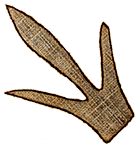 MENU
MENU
 MENU
MENU

These two images show how easy it was to mistake dinosaur footprints for those of a large bird. The image on the left is of modern day bird footprints. The image on the right shows fossil footprints, probably created under somewhat similar conditions. Image courtesy of Albertus Gorman (left) and thefossilforum.com (right).
Intrigued by the "bird tracks" in the sidewalk, Marsh continued to study and collect them in his spare time, becoming a highly knowledgeable amateur paleontologist in the process. He came to know Edward Hitchcock, the Amherst College professor to whom his neighbor Dr. Deane had written about the tracks.
Marsh learned that fossil footprints were found only in sandstone, such as shale and siltstone, and finer sedimentary rocks, not other local rocks such as granite, gneiss, basalt, schist, or conglomerate. Through trial and error, he searched out the richest sites for digging. Before removing any tracks, he would check to see if several were in sequence and then observe how all the tracks related to one another, how deep or shallow the impressions, how far apart from side to side and from the toe of one print to the heel of the next. He learned to discern whether an animal had been moving on land or in shallow water.
He read articles by Deane, Hitchcock, and many others who took up the subject, including men in Boston and as far away as London. He and Deane sometimes worked together, commenting on what they found and conjecturing how each track had been made.
Either Deane or Hitchcock introduced Marsh to members of the Boston Society of Natural History and other academics and interested dabblers in geology, and these men began to buy his fossil specimens. Among them were Benjamin Silliman, William Redfield, James Hall, Charles T. Jackson, and Thomas T. Bouvé. The popular Harvard scientist Louis Agassiz even referred directly to Marsh in one of his books.
It was quite a heady experience for a man who lived by physical labor, was sexton (janitor) at the church across the way from his home, performed various tasks for town hall, rented out rooms to boarders, and needed to do odd jobs in the evening to bring in more income.
Next chapter: Joining the Middle Class through the Fossil Trade